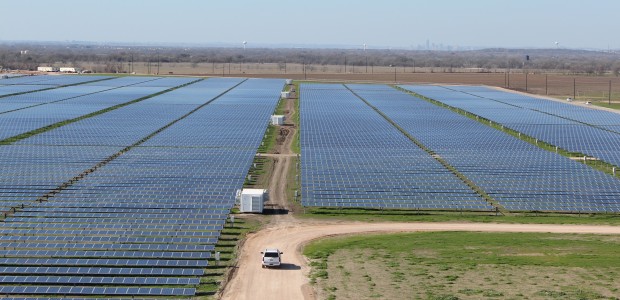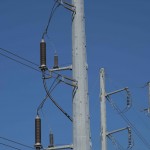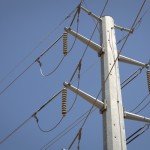A Look to the Future at Texas’ Largest Solar Farm

Mose Buchele / StateImpact Texas
The 380 acre Webberville Solar Farm outside of Austin will power 5000 homes.
A ribbon-cutting ceremony Friday marked the official opening of the Webberville Solar Farm, an array of 127,000 solar panels set to provide enough electricity to power 5,000 homes in the Austin area. The farm will be the largest of its kind in Texas, and is the largest solar project of any public power utility in the United States, according to Austin Energy CEO Larry Weiss.
Politicians, green energy advocates and industry representatives were on hand, hoping the event would showcase the promise of renewable energy after a turbulent year for the solar industry.
“Last year was a contraction year. [Our company] actually grew, but the industry itself had to go through a contraction and some of the weaker players didn’t survive,” Mark Menedenhall, GM of Sun Edison told StateImpact Texas. Sun Edison is the company contracted by the City of Austin to build the solar farm.
Mendenhall said the future of solar was bright, in part due to projects like the Webberville Farm.
“As more and more solar plants are deployed they’re being viewed as less risky,” he said.
Less risk means solar power investors are demanding a smaller return on investment.
“So that also reduces the cost of capital.” Mendenhall said. “All these factors together are what’s driving this proven technology to continue to reduced the cost per watt.”
Mendenhall expects the price of solar electricity per watt to reach parity with the cost of electricity generated by fossil fuels within a two years.
Others weren’t so optimistic.
Chasing a Moving Target
When asked by StateImpact Texas about solar’s competitiveness with other forms of electric generation, H.B. “Tripp” Doggett, President of the Electric Reliability Council of Texas (ERCOT) said he wasn’t sure when solar would become competitive.
One reason it’s hard to speculate is that solar electricity generators are chasing a moving target. The cost of solar electricity is falling year by year, but the cost of other forms of electricity has fallen as well. Power plants powered by natural gas, for example, might drop their prices lower if they find themselves threatened by a burgeoning solar industry.
“Competition between generation units with one another, that competition tends to drive the price downward and so that could have had some impact [on growth of solar in Texas], Doggett said.
ERCOT is projecting a growing need for energy in the state in the coming years, and announced last December that fewer electricity projects will be coming online than it expected. That’s prompted fears of more rolling blackouts like the ones Texas saw last winter.
When asked about the solar farm’s contribution towards keeping Texas blackout-free, Doggett was circumspect.
“Every little bit helps, this is not a tremendous magnitude of additional megawatts, but every little

Mose Buchele / StateImpact Texas
Trip Doggett is the President of the Electric Reliability Council of Texas
bit helps,” said Doggett. “We’re glad to have this as a very large facility, as solar farms go. Its not equivalent to a large new fossil-fired plant but we certainly need all of the additional generation we can get.”
One benefit of the solar farm is that it will generate that power at exactly the time it is most needed.
Solar produces the most electricity during hot, sunny weather — times of peak demand — said Mathew Weldon of Solar Austin, a local nonprofit that promotes renewable energy.
Weldon said the real benefit of solar, the fact that it comes free of polluting emissions, should be taken into account when consumers consider the price competitiveness of energy sources.
“As we’re forced to recognize some of the negative externality costs associated with fossils fuels, the inherent value of solar will be recognized also and so the projects will become more common,” Weldon said.



